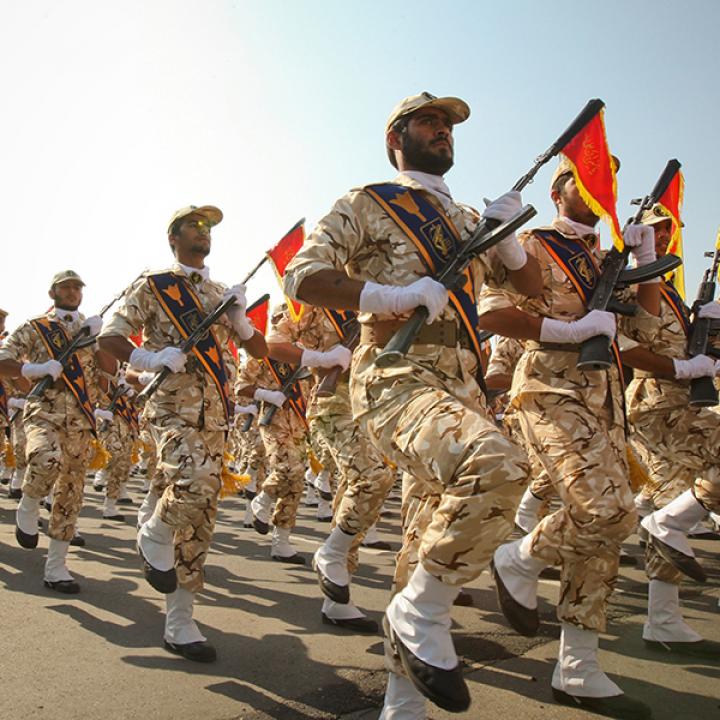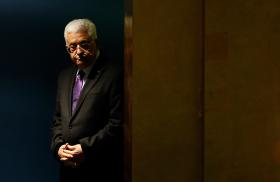
- Policy Analysis
- PolicyWatch 3049
The IRGC and Regional Conflict: Temperature Rising

The author of a landmark new book on the IRGC joins two Iran scholars for a lively conversation on how best to understand the force’s origins and exploit its weaknesses.
On December 7, Nader Uskowi, Ali Alfoneh, and Alex Vatanka addressed a Policy Forum at The Washington Institute. Uskowi is a senior military advisor and author of the new book Temperature Rising: Iran Revolutionary Guards and Wars in the Middle East (Rowman & Littlefield), which he completed during his time as an Institute fellow. Alfoneh is a senior fellow at the Arab Gulf States Institute and author of Iran Unveiled: How the Revolutionary Guards Is Turning Theocracy into Military Dictatorship (2013). Vatanka is a senior fellow at the Middle East Institute and author of Iran and Pakistan: Security, Diplomacy, and American Influence (2015). The following is a rapporteur’s summary of their remarks.
NADER USKOWI
One question my new book addresses is who created the Islamic Revolutionary Guard Corps-Qods Force and how exactly it was established. Leading up to the revolution, Ayatollah Ruhollah Khomeini and his advisors expected there to be a long period of conflict in Iran before the shah would feel compelled to step down. In planning for this period, they discussed forming a people’s army that could force him to leave the country and subsequently prevent a coup against them. Although the shah wound up leaving without resistance, the idea of a people’s army did not fade.
Indeed, just a few weeks after the revolution, the new regime began laying the foundation for a Shia militia by recruiting Afghan refugees who had fled socialist rule in Kabul. Iranian commanders organized these refugees into separate fighting forces and sent them back to Afghanistan, where they fought the socialist government and the Soviets. This vision of recruitment continued during the Iran-Iraq War, when many Iraqis joined the Iranian side to fight Saddam Hussein, and later in Lebanon, where Tehran encouraged the formation of Hezbollah. More recently, the regime has extended its foreign militia operations into Syria.
Another longstanding question is whether the IRGC acts as an independent organization or one subject to the Supreme Leader’s authority. When the revolution occurred, two power circles emerged in Tehran: the government, which ran day-to-day duties, and the revolutionary organ, which oversaw the formation and organization of the IRGC and Qods Force. At the same time, the Supreme Leader, who sat at the top of the revolutionary organ’s hierarchy, had and continues to have a complex relationship with the Qods Force, largely stemming from the group’s intention to outlast the Islamic Republic. To be sure, the Qods Force needs the Supreme Leader to legitimize its religious foundation and attract Shia recruits. In theory, though, it could operate on its own, especially now that it controls an array of businesses outside Iran, has weapons caches all over the Middle East, and has direct access to more than 50,000 Shia fighters in the region.
Regarding its military capabilities and tactics, the Qods Force incorporates both asymmetric and conventional means. In Syria, it has gone further than its original mission of saving Bashar al-Assad’s regime, commencing efforts to challenge Israel on Syrian soil. This overreach has created opportunities for Washington to challenge the organization’s freedom of movement in the region, disrupt its businesses outside Iran, and deny it access to the air and seaports it uses for smuggling.
As for the prospect of compromise between the United States and Iran, the Yemen war seems like one of the few items from Secretary of State Mike Pompeo’s past list of demands that they can work toward addressing. Saudi Arabia and its allies have found weak points in Iran’s strategy there, choking off arms shipments to the Houthi rebels, so Tehran may be more willing to negotiate an end to the conflict.
ALI ALFONEH
Some contend that the Qods Force was created just weeks after the revolution, but it actually arose far earlier. Its first incarnation was established by Egyptian leader Gamal Abdul Nasser in 1964. After the Iranian coup of 1953, revolutionaries decided that it was not possible to overthrow the shah through a political campaign. Instead, they decided they must initiate a military struggle against him, and Egypt was the only country willing to provide them with money, training, and arms. Through this process, Iranian revolutionaries connected with their counterparts around the region, building a transnational revolutionary movement.
As these Iranians built up their capabilities, the country’s SAVAK intelligence service began to chase them around the region, closely following their activities. After the shah’s downfall, revolutionaries seized SAVAK’S headquarters, and many of the agency’s officers decided to join the newfound IRGC during the unrest that followed. By combining the capabilities of revolutionaries and SAVAK officers, the IRGC evolved into the adept organization it is today.
While the IRGC has a track record of significantly influencing Iran’s neighbors, the civilian government has had far less success. Some consider Qods Force leader Qasem Soleimani as someone who could shake off the government’s reputation for ineptitude and corruption if he ran for office, but he would not be a capable politician. Rather than paying attention to his political potential, officials would be better served by developing a deeper understanding of the Qods Force as an institution. The organization’s propensity for independent action is growing in many ways, so assessing its strategic goals is essential to forecasting the Islamic Republic’s vision for the future.
ALEX VATANKA
Some observers believe that the Islamic Republic as a system works well, but this notion is devoid of any truth. The regime is more a product of its reaction to circumstances than a smooth-running system. Khomeini himself had no idea what he wanted when he left Paris for Tehran in 1979. And while many argue that his movement was ideologically driven, the Islamic world quickly turned against his regime and its policies. Indeed, his closest foreign allies were Muammar Qadhafi of Libya and Hafiz al-Assad of Syria—two leaders whose policies were far from ideological. The Islamic Republic is thus better understood as an opportunistic rather than an ideological entity.
The regime has demonstrated this opportunistic nature through its foreign policy. For instance, it has long confined its military involvement to destabilized countries where other foreign actors have already made mistakes. This involvement spans from Lebanon in 1982, when it helped create Hezbollah, to Iraq after the outbreak of war in 2003, and to Yemen today. Whatever success Iran has had in these theaters does not attest to any strength in its message, but rather to its skill in identifying and exploiting regional power vacuums.
The United States can counter this strategy by pursuing regional opportunities in its own way. The key is to exploit the two most obvious weaknesses in Iran’s proxy model: the fact that a majority of Iranians disapprove of the regime’s foreign policy, and that many Shia Arabs detest velayat-e faqih, the concept under which the Iranian regime claims absolute authority. In light of these weaknesses, Washington should initiate a more robust public messaging campaign. It should also attempt to disconnect the Qods Force from the many foreign militias it has helped train. These proxy groups are individual actors within their own unique national settings, so their relationships with Iran are far more nuanced than is commonly appreciated.
Another approach is to consider negotiating with Iran, but this track would run into significant problems. Iran is currently consumed with factional infighting that hampers its ability to speak with one voice. The IRGC and the government do not agree on how to move forward after the reimposition of U.S. sanctions, so there is uncertainty about who would represent Tehran in any negotiations, and what interests would be given priority.
This summary was prepared by Arjan Ganji.





